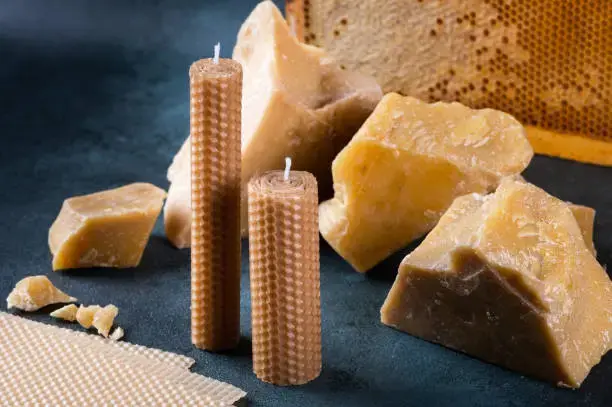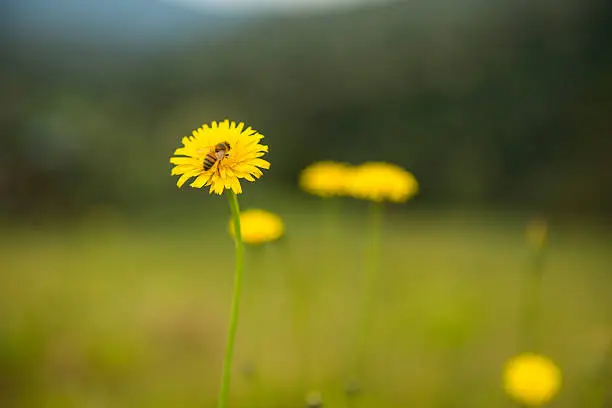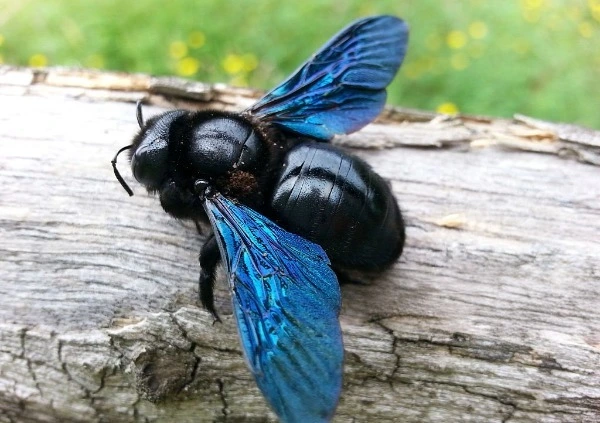What is Bee wax? Characteristics, Composition, Application, Benefits, Other Waxes.
Bee wax
Cera alba, or bees wax, is a naturally occurring wax that is made by Apis honey bees. Beeswax is a waxy substance created by young honey worker bees. Beekeepers use beeswax to form cells in their hives. These cells’ distinctive “honeycomb” pattern is produced by their hexagonal shape. The workers in the hive gather it and use it to create cells that store honey and provide protection for the larvae and pupae inside the beehive.

Physical characteristics of bee wax
| Wax content type | Percentage |
| Hydrocarbons | 14% |
| Monoesters | 35% |
| Diesters | 14% |
| Triester | 3% |
| Hydroxy monoesters | 4% |
| Hydroxy polyesters | 8% |
| Acid esters | 1% |
| Acid polyesters | 2% |
| Free fatty acids | 12% |
| Free fatty alcohols | 1% |
| Unidentified | 6% |
Chemical composition of bees wax
Bees wax is a complex mixture of various compounds, primarily consisting of esters, fatty acids, and hydrocarbons. Here’s a breakdown of its chemical composition:
Esters:
- Beeswax Esters: These are the major constituents of beeswax, accounting for about 70-75% of its composition. Beeswax esters are formed by the combination of long-chain fatty acids and long-chain alcohols. Examples include myricyl palmitate, myricyl cerotate, and myricyl palmitoleate.
Fatty Acids:
- Palmitic Acid: This saturated fatty acid is a significant component of beeswax, contributing to its solid and stable nature.
- Oleic Acid: Another fatty acid commonly found in beeswax.
Hydrocarbons:
- Straight-Chain Hydrocarbons: Beeswax contains straight-chain hydrocarbons, such as n-hexacosane and n-octacosane. These hydrocarbons contribute to the firmness and structure of beeswax.
- Monounsaturated Hydrocarbons: Some monounsaturated hydrocarbons, like triacontene, are also present.
Alcohols:
- Triacontanol: This alcohol is found in beeswax, though it is present in relatively small amounts.
Other Components:
- Free Fatty Acids: In addition to esters, there are trace amounts of free fatty acids.
- Pigments and Pollutants: Depending on the environmental conditions and the region where the bees are located, beeswax may contain trace amounts of pigments and environmental pollutants.
Bees wax vs. Other Waxes
Beeswax: Derived from bees, beeswax is a natural substance. It contains no synthetic additives or harmful chemicals. Beekeeping practices can support environmental sustainability, contributing to pollination and biodiversity. Generally considered safe for human use, beeswax is often used in cosmetics and skincare due to its hypoallergenic properties.
Synthetic Waxes: Manufactured from petrochemicals, synthetic waxes may contain additives and by-products of the petroleum refining process. Production processes for synthetic waxes may involve non-renewable resources and generate environmental pollutants. Depending on the specific formulation, synthetic waxes may contain allergens or irritants for some individuals.
Benefits of Beeswax
| Natural and Non-Toxic |
| Moisturizing for Skin |
| Soothing Properties |
| Clean-Burning Candles |
| Versatile in DIY Projects |
| Protective Coating for Wood and Leather |
| Water-Resistant |
| Natural Hold in Hair Care |
| Food Preservation |
| Environmental Sustainability |
| Biodegradable |
| Pleasant Aroma |
| Healing Properties |
Applications of Bees wax
Candle Making:
Beeswax is popular for crafting candles due to its natural honey-like fragrance, slow and clean burn, and the warm glow it produces. Beeswax candles are often considered environmentally friendly.
Cosmetics and Skincare:
Found in various cosmetic and skincare products like lip balms, lotions, and creams, beeswax provides a natural barrier that helps retain moisture in the skin. It is valued for its soothing and protective qualities.
Read More: 15 Honeycomb Remedies for Skin Care
Wood and Leather Finishes:
Beeswax is used in woodworking and leatherworking to create natural finishes. It can enhance the appearance of wood, providing a protective layer that also brings out the natural grain. Similarly, it can be applied to leather for conditioning and protection.
Food Preservation:
Beeswax has been historically used to coat cheeses, fruits, and vegetables, creating a protective layer that helps preserve freshness. It is a natural alternative to synthetic coatings in the food industry.
Art and Craft Supplies:
Artists and crafters use beeswax in various mediums, such as encaustic painting, where it is melted and mixed with pigments to create a unique artistic effect. Beeswax is also used in the creation of natural modeling waxes.
Hair Care Products:
Beeswax is a common ingredient in hair care products such as pomades and styling waxes. It provides a natural hold without the use of synthetic additives.
Waterproofing Fabrics:
Due to its water-resistant properties, beeswax is employed in waterproof fabrics and clothing items, especially outdoor gear like jackets and hats.
DIY Projects:
Beeswax is popular in do-it-yourself (DIY) projects. People use it to create homemade products such as lip balms, candles, and furniture polishes.
Natural Lubricant:
Beeswax can be used as a natural and non-toxic lubricant for various applications, including the lubrication of drawers, zippers, and other moving parts.
Medicinal Uses:
While not a replacement for medical treatment, beeswax has been historically used in traditional medicine for its anti-inflammatory and antibacterial properties. It is sometimes included in natural remedies, such as salves and ointments.
Read More: Honeycomb Heart Health
FAQs
What are the main components of beeswax?
Beeswax primarily consists of esters, fatty acids, and hydrocarbons. The exact composition can vary based on factors like bee species and environmental conditions.
How is beeswax harvested from beehives?
Beekeepers typically harvest beeswax when collecting honey. After extracting the honey, the beeswax is carefully removed from the honeycombs and processed for various uses.
Can beeswax be used in skincare products?
Yes, beeswax is commonly used in skincare products like lip balms and creams. It provides a natural barrier that helps retain moisture and is known for its soothing properties.
Is beeswax environmentally friendly?
Beekeeping practices, when sustainable, can be environmentally friendly as they support pollination and biodiversity. Additionally, beeswax itself is biodegradable.
Can beeswax be used for waterproofing?
Yes, beeswax has water-repellent properties, and it is often used to waterproof fabrics and outdoor gear.
Is beeswax safe for those with allergies?
Beeswax is generally considered hypoallergenic, making it a safe option for individuals with sensitive skin. However, it’s advisable to test a small amount first to ensure no adverse reactions.





